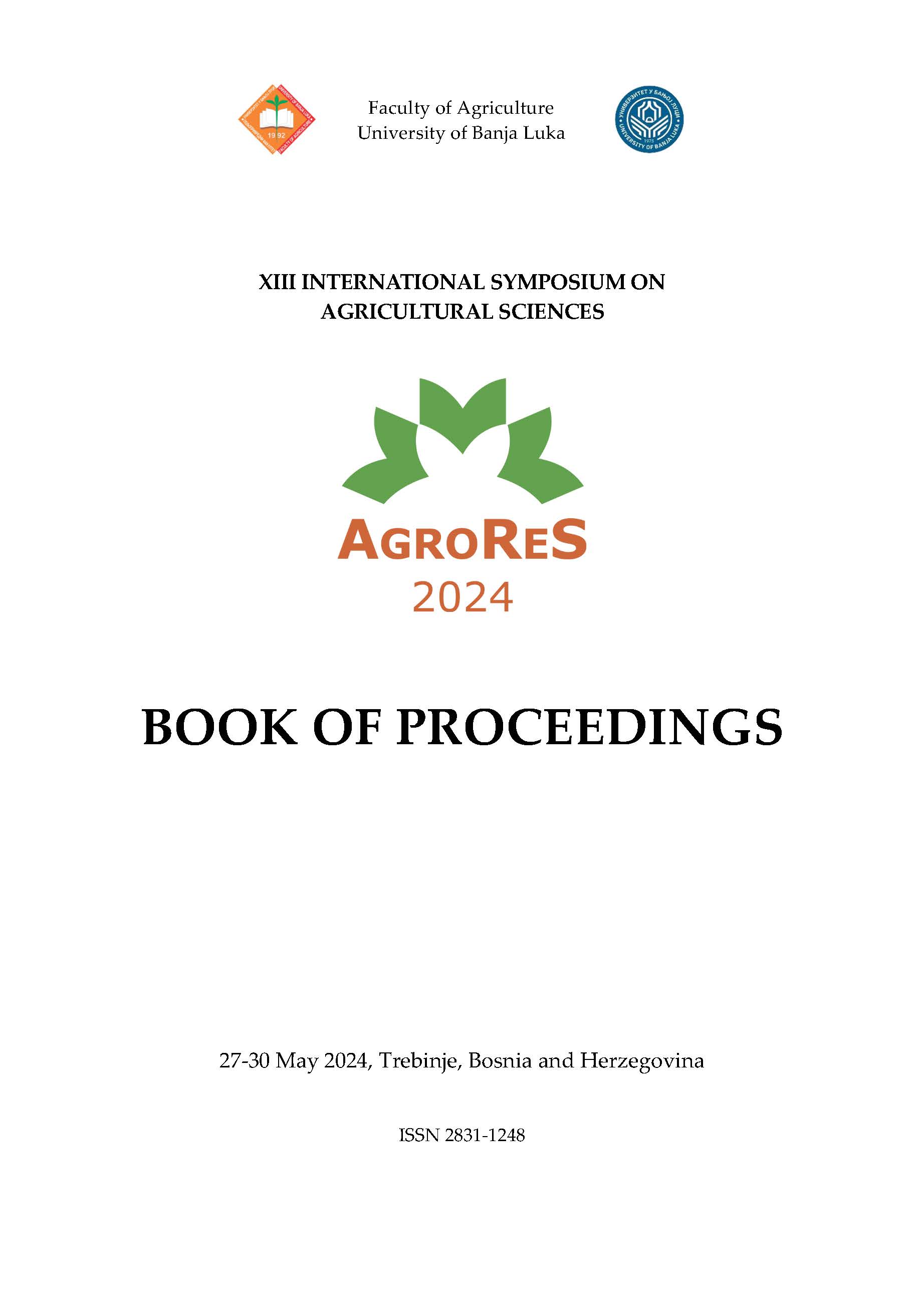The influence of different fertilization methods on the components of yield and the grain yield of faba bean (Vicia faba ssp. eufaba var. minor)
DOI:
https://doi.org/10.7251/ZARS2401097LKeywords:
Vicia faba var. minor, fertilization treatment, number of pods, grain yieldAbstract
The research was carried out on the experimental field of the PI Agricultural Institute of the Republic of Srpska, Banja Luka in 2021 and 2022. These studies aimed to investigate the impact of different fertilization treatments on yield components and grain yield of faba bean (Vicia faba var. minor) in the agro-ecological conditions of the Banja Luka region. The experiment was set up in four replications in a randomized block system. In both years of the experiment, beans were sown by hand in March with 160 kg ha-1 of grains. Four fertilization treatments were applied to the faba bean crop: control, 300 kg ha-1 NPK 15:15:15, 250 ml ha-1 Slavol S, and 300 kg ha-1 NPK 15:15:15 + 250 ml ha-1 Slavol S. During these tests, the following properties were monitored: plant height, number of pods/plant, length of pods, number of grains/pods, mass of grains/pods, mass of 1000 grains and yield of grains/ha. In the first year of research, the average height of the faba bean plants varied from 78.8 cm in the Slavol S treatment to 83.0 cm in the NPK 15:15:15 + Slavol S treatment. The highest average number of grains/pods and the number of pods/ plants was found in faba bean plants that were grown in the treatment with NPK 15:15:15 + Slavol S. In the second year of research, the faba bean plants in the treatment with Slavol S were the lowest, and the plants in the treatment with NPK 15:15:15 had the highest average height. Faba bean plants grown in the NPK 15:15:15 treatment had the highest average number of grains/pods and the longest pod length in 2022. This research achieved the highest average two-year faba bean grain yield with NPK 15:15:15 + Slavol S treatment, respectively 2 958.5 kg ha-1.
References
Adak, S.M., & Kibritci, M. (2016). Effect of nitrogen and phosphorus levels on nodulation and yield components in faba bean (Vicia faba L.). Legume Research, 39 (6), 991-994.
Akgun, D., & Canci, H. (2023). Selection of Faba Bean (Vicia faba L.) Genotypes for high yield, essential amino acids and low anti-nutritional factors. Agriculture, 13(5), 932. DOI: https://doi.org/10.3390/agriculture13050932
Alghamdi, S.S. (2007). Genetic behavior of some selected faba bean genotypes. African Crop Science Conference Proceedings, 8, 709-714.
Bodnera, G., Kronbergab, A., Lepsec, L., Olled, M., Vågen, M.I., Rabanteb, L., Fernandezf, J., Ntatsig, G., Balliuh, A., & Rewaldi, B. (2018). Trait identification of faba bean ideotypes for Northern European environments. European Journal of Agronomy, 96, 1-12. DOI: https://doi.org/10.1016/j.eja.2018.02.008
Dewangan, N.K., Dahiya, G.S., Janghel, D.K., & Dohare, S. (2022). Diversity analysis for grain yield and its component traits among faba bean (Vicia faba L.) germplasm lines. Legume Research, 45(6), 689-694. DOI: https://doi.org/10.18805/LR-4301
Etemadi, F., Hashemi, M., Zandvakili, O., & Mangan, F.X. (2018). Phenology, yield and growth pattern of faba bean varieties. International Journal of Plant Production, 12(4), 243-250. DOI: https://doi.org/10.1007/s42106-018-0023-1.
Kubure, T.E., Cherukuri, V.R., & Hamza, I. (2016). Production potential of Faba bean (Vicia faba L.) genotypes in relation to plant densities and phosphorus nutrition on vertisols of Central highlands of West Showa Zone, Ethiopia, East Africa. Advances in Crop Science and Technology, 4(2), 1-9.
Lakić, Ž., Nožinić, M., Antić, M., & Popović, V. (2022). The influence of the bio stimulator on the yield components and yield of faba bean (Vicia faba var. minor). Notulae Botanicae Horti Agrobotanici Cluj-Napoca, 50(4), 12998. DOI: https://doi.org/10.15835/nbha50412998
Lombardo, S., Pandino, G., Pesce, G.R., Anastasi, U., Tuttobene, R., & Mauromicale, G. (2016). Variation in grain mineral elements profile and yield in field bean (Vicia faba L. var. minor) genotypes. Italian Journal of Agronomy, 11(4), 261-267.
Merga, B., Egigu, M.C., & Wakgari, M. (2019). Reconsidering the economic and nutritional importance of faba bean in Ethiopia. Cogent Food & Agriculture, 5(1), 1683938. doi.org/10.1080/23311932.
Neugschwandtner, R., Ziegler, K., Kriegner, S., Wagentristl, H., & Kaul, H.P. (2015). Nitrogen yield and nitrogen fixation of winter faba beans. Acta Agriculturae Scandinavica, Section B — Soil & Plant Science, 65, 658-666.
Olle, M., Williams, H. I., & Rosa, E. (2019). Selecting appropriate faba bean var. minor varieties for production under Northern European environmental conditions. Acta Agriculturae Scandinavica, Section B — Soil & Plant Science, 69(5), 432-438. DOI: doi.org/10.1080/09064710.2019.1595126
Papakaloudis, P., & Dordas, Ch. (2023). Phosphorus fertilization affects morphological, physiological and agronomic characteristics of Faba bean cultivars. Sustainability, 15(17), 13172. DOI https://doi.org/10.3390/su151713172
Sharifi, P. (2018). Biplot analysis of grain yield of faba bean genotypes at different planting dates. Agriculture and Forestry, 64(4), 243-250. DOI: https://doi.org/10.17707/AgricultForest.64.4.24
Stoddard, F.L., Nicholas, A.H., Rubiales, D., Thomas, J., & Villegas Fernández, A.M. (2010). Integrated pest management in faba bean. Field Crops Research, 115(3), 308-318.
Yitayih, G., & Azmeraw, Y. (2017). Adaptation of faba bean varieties for yield, for yield components and against faba bean gall (Olpidium viciae Kusano) disease in South Gondar, Ethiopia. Crop Journal, 5(6), 560-566. DOI: https://doi.org/10.1016/j.cj.2017.05.007.
Downloads
Published
Issue
Section
License
Copyright (c) 2025 Željko Lakić, Marina Antić, Gordana Babić

This work is licensed under a Creative Commons Attribution-NonCommercial-NoDerivatives 4.0 International License.



